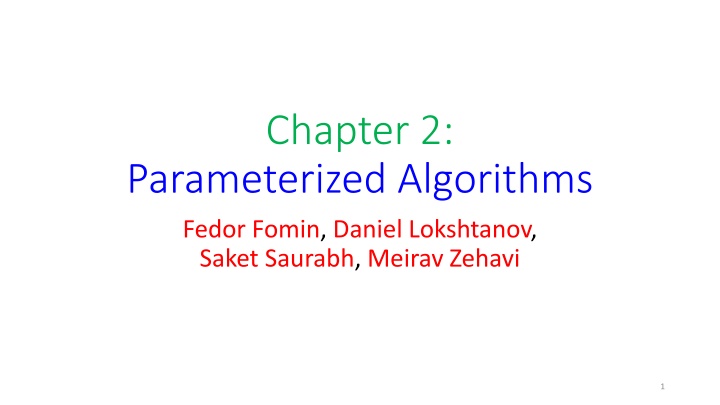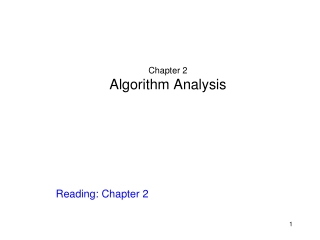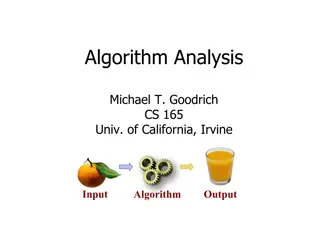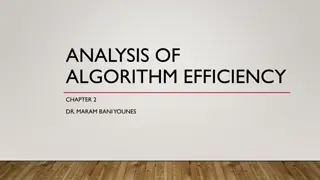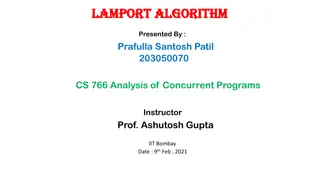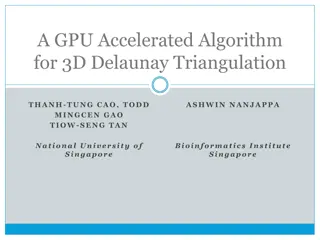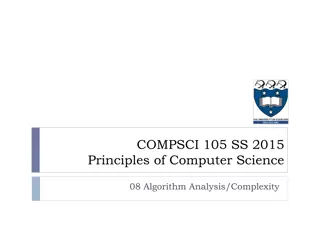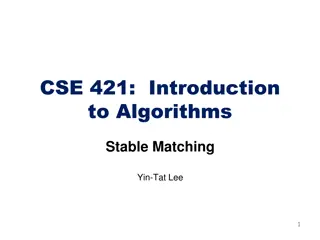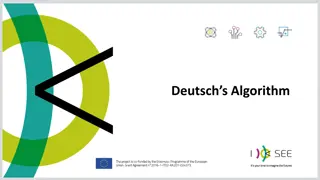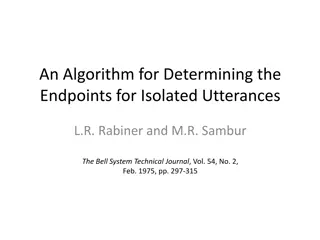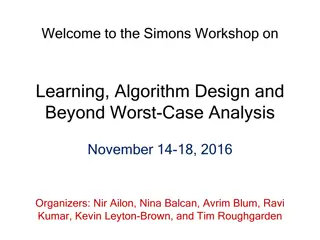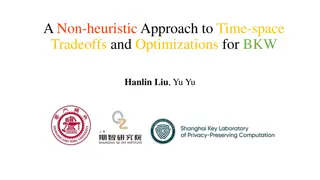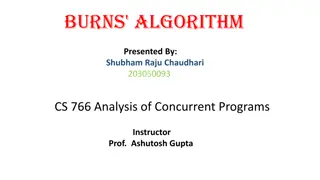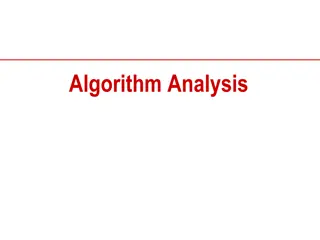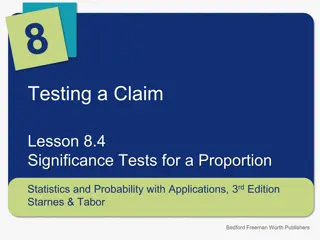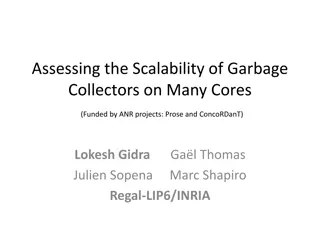Algorithm Analysis and Scalability
Algorithm analysis involves studying the running times of algorithms and their performance based on input size. Scalability is essential for systems to handle growing workloads effectively. Learn about algorithms, data structures, running times, experimental studies, important functions, and why growth rate matters in this comprehensive overview.
Uploaded on Apr 13, 2025 | 0 Views
Download Presentation

Please find below an Image/Link to download the presentation.
The content on the website is provided AS IS for your information and personal use only. It may not be sold, licensed, or shared on other websites without obtaining consent from the author.If you encounter any issues during the download, it is possible that the publisher has removed the file from their server.
You are allowed to download the files provided on this website for personal or commercial use, subject to the condition that they are used lawfully. All files are the property of their respective owners.
The content on the website is provided AS IS for your information and personal use only. It may not be sold, licensed, or shared on other websites without obtaining consent from the author.
E N D
Presentation Transcript
Chapter 2: Parameterized Algorithms Fedor Fomin, Daniel Lokshtanov, Saket Saurabh, Meirav Zehavi 1
Basic idea When standard worst case analysis (expressing running time as a function of size of input instance) is not sufficiently informative: Identify parameters of interest (like we did with properties of the working set function for online paging, or the margin for the Perceptron algorithm). With respect to these parameters, perform worst case analysis. For a good choice of parameter, the corresponding worst case analysis becomes more informative. 2
Example minimum vertex cover Select the smallest number of vertices that cover all edges. NP-hard. 3
Example minimum vertex cover Select the smallest number of vertices that cover all edges. NP-hard. 4
A parameter for vertex cover ? vertices and ? edges. ? the size of the smallest vertex cover. Can find the minimum vertex cover in time ? exhaustive search. Polynomial in ? for constant ?. Can we have a polynomial time algorithm when ? is a (slowly) growing function of ?? ?? ???+1 by 5
A simple algorithm for min vertex cover Let ? denote an arbitrary vertex cover (unknown to us) of size ?. Pick an arbitrary uncovered edge. Fork into two processes, each including a different endpoint of the edge in its vertex cover. Necessarily, at least one of the forks includes only vertices of ?. At depth ?, found ?. Running time ?(2???). Polynomial for ? = ?(log?). 6
A faster algorithm Let ? denote an arbitrary vertex cover (unknown to us) of size ?. If no vertex has degree larger than 2, the graph is composed of paths and cycles. Find the minimum vertex cover. Otherwise, pick a vertex ? of highest degree. Fork into two processes, one including ? in its vertex cover, the other including the neighbors of ?. Necessarily, at least one of the forks includes only vertices of ?. ? ? ? ? 1 + ? ? 3 At most ?? forks, for ? 1.47 (solution to ?3= ?2+ 1). 7
Fixed parameter tractability A computational problem (e.g., min vertex cover) is fixed parameter tractable (FPT) with respect to parameter ? (of value ?) if it has an algorithm running in time ? ? ??. ? is independent of ? and ?. ? can be a fast growing function (exponential, or even more). XP (slice-wise polynomial) algorithms: running time ? ? ?? ?. Polynomial for fixed ?. 8
Examples of classifications Min vertex cover (parameter: size of vertex cover): FPT. Max independent set (parameter: size of independent set): XP. Believed not to be FPT. (W[1]-hard.) Max independent set (parameter: size of vertex cover): FPT. Min vertex coloring (parameter: value of chromatic number): NP-hard for ? = 3. Not XP unless P=NP. 12
Randomized FPT algorithms Expected running time ? ? ??. Expectation taken only over randomness of algorithm (the input instance is not random). If expected running time is ?, then by restarting every 2? steps, ensure probability of success of at least 1 2 ? in time 2?? (for every integer ? 1). For many randomized algorithms, get stronger results: probability of success of at least 1 ? ? in time ??, even without restarting. 13
Set splitting A 2-coloring of items splits a set if it has items of both colors. Given a collection of sets, find a 2-coloring that splits as many sets as possible. If every set has two items (an edge in a graph in which items are the vertices), set splitting is max-cut. More generally, set splitting is max- cut in hypergraphs. NP-hard. Parameter ?, the maximum number of sets that can be split simultaneously. 14
Randomized algorithm for set splitting Observe, in the optimal 2-coloring, there is a set ? (unknown to us) of at most 2? items that certifies that ? sets are split. 2-color the items independently at random. Check if ? sets are split. The check succeeds with probability at least 2 2? (it suffices that ? is 2-colored correctly). Repeat until a 2-coloring that splits ? sets is found. The expected number of repetitions is not more than 22?. Expected running time: 22?????(?). (In fact, 2?????(?).) 15
Longest path 16
Longest path 1 2 3 7 6 4 5 17
Longest path and Hamiltonicity Longest path is NP-hard: Hamiltonian path is a special case. Na ve algorithm: try all permutations of vertices. Time O (?!). Dynamic programming [Bellman 1962; Held and Karp 1962]: A state is (?,?,?). It is legal if there is a simple path that starts at ?, visits all of ?, and ends in ?. A path extension move: if ?,? ? and ? ? {?} then can move from (?,?,?) to (?,? ? ,?). BFS in state graph. Time O (2?). ? : up to low order multiplicative terms. 18
Further comments on Hamilton path Dynamic programming uses exponential space. There is an algorithm based on the inclusion-exclusion principle that has running time ? (2?) and uses only polynomial space [Kohn, Gottlieb and Kohn 1977; Karp 1982; Bax 1993 ...]. There is a randomized algorithm with running time ? (1.657?) and polynomial space [Bjorklund 2014]. 19
Longest path is fixed parameter tractable Parameter: length ? of the path. Color coding [Alon, Yuster and Zwick 1995]. Repeat until success: Color vertices of ? independently at random with ? colors. Search for a colorful path of length ?. Probability that a ?-path becomes colorful is ?! The expected number of repetitions is at most ??. ?? ? ?. 20
Finding a colorful ?-path Dynamic programming: A state is (?,?,?), where ? is a set of colors. It is legal if there is a simple path that starts at ?, visits all colors of ?, and ends in ?. A path extension move: if ?,? ? and ?(?) ? and ? ?, then can move from (?,?,?) to (?,? ?(?) ,?). BFS in state graph. Time 2?????(?). Overall, expected running time is 2??????(?). 21
Derandomization [Naor, Schulman and Srinivasan 1995] We presented randomized FPT algorithms for set splitting and for longest path. They can be derandomized. There exists an algorithm running in time ??????(?) that produces ?(??+? ?log?)?-coloring functions such that for every set of ? items, at least one of the functions makes it colorful. There exists an algorithm running in time 2?+?(?)????(?) that produces ?(2?+? ?log?)2-coloring functions such that for every set ? of ? items and every 2-coloring of ?, at least one of the functions agrees with the 2-coloring of ?. 22
Kernelization Preprocess the instance so as to replace it by a smaller instance with the same solution. Kernelization involves two functions ?1 and?2. Input: instance (?,?), where ? is the value of the parameter. Output: instance ?1?,? = (?,? ). Requirements: ?1 computable in time ?(|?|?1) (regardless of ?). ? ?2(?) and typically ? ? (or more generally, ? ?2(?)). 23
Significance of kernelization Suppose ? can be solved in time ?(|?|). If the problem has kernelization with functions ?1 and?2 then the problem is FPT: (?,?) can be solved in time ? ??1 + ?(?2? ). A problem is FPT iff it has a kernel. FPT running time ? ? ?? implies kernel of size ?(?) in time ??+1. Suppose (?,?) can be solved in FPT time ? ? ?(|?|). If the problem has kernelization with functions ?1 and?2 then (?,?) can be solved in time ? ??1 + ?(?)?(?2? ). 24
Buss kernelization for vertex cover ?,? Remove isolated vertices. If deg ? > ?, replace by (? ? ,? 1). (? must be in VC.) No solution if instance has more than ?2 edges. Preserves all minimal solutions of size at most ? of the VC instance. Gives a polynomial kernel, of size ?(?2). Hence can solve vertex cover in time ?? 1+ ?2??. Though every FPT problem has a kernel, some FPT problems (such as ?-path) do not have a polynomial kernel (unless ???? ??/????). [Bodlaender, Downey, Fellows, Hermelin 2009; Fortnow, Santhanam 2011] 25
Conditional negative results It could be that all problems in NP are FPT (if P=NP). Hence claims that a problem is not FPT are conditioned on some complexity assumption. The assumption ? ?? often does not suffice. Other assumptions: Exponential time hypothesis (ETH): 3SAT takes time 2 ?. SETH: for ? > 0, SAT cannot be solved in time 2 ??. W[1]-hardness: ?-clique is not FPT. (Weaker assumption than ETH, as it follows from it.) Polynomial hierarchy PH does not collapse. 26
?-clique is not FPT (sketch) Suppose ?-clique can be solved in FPT time 2??2. By a subset construction, in a graph of size ? a clique of size ?/2 can be found in time ??( ?). A sequence of reductions shows that this violates ETH. For every ? > 0, every 3SAT instance can be reduced to 2?? instances, each with linearly many clauses [Impagliazzo, Paturi, Zane 2001]. There is a linear reduction from 3SAT to CLIQUE. Hence 3SAT can be solved in time 2? ?. 27
The subset construction In a graph ? on ? vertices, need to find a clique of size ? For simplicity, assume that ? is divisible by 2 ? log?. 2. ? ?/(2 log ?) ?? vertices. Create a graph ? on at most ? = Every clique of size ?/(2 log?) in ? is a vertex of ?. Two vertices of ? are connected by an edge if together they form a clique of size ?/log? in ?. ? has a clique of size ? 2 iff ? has a clique of size ? = By FPT assumption, can find clique in ? in time 2??2= ?? ?log?. ?. 28
